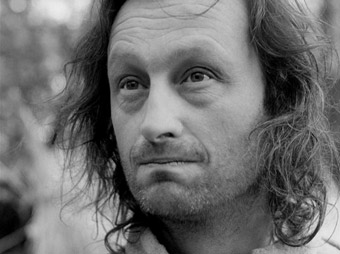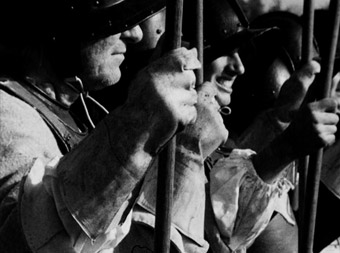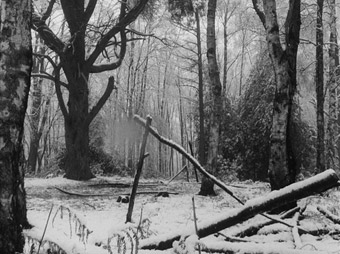"For freedom is the man that will turn the world upside down.
Therefore, no wonder he has enemies." |
Gerard Winstanley |
If you'll excuse the gross generalization, we don't tend to remember our revolutionaries in England. Look at the pantheon of our historical heroes and you'll see a dominance of war veterans, monarchs, scientists, inventors – as well as writers and artists of course – but not many political agitators. Popular historical memory jumps to Richard II over Wat Tyler, William Pitt over William Cobbett, Margaret Thatcher rather than Arthur Skargill. When thinking of the 17th Century we tend to remember the dictatorship of Cromwell or the autocracy of Charles I, rather than the radicalism of the Pamphleteers or the Levellers. Given the seismic political and social changes of the time – civil war, regicide, republicanism – the comparatively sedate story of Gerard Winstanley is often overlooked. He was the founder of a commune at St George's Hill in Surrey, a small colony of people who cultivated waste land and shared the proceeds amongst themselves, following the advice contained in Winstanley's writings. Drawing the ire and invetible reprisals of local landowners, the experiment was short lived but had a lasting effect, and was a strange, rare example of English communism at work. Andrew Mollo and Kevin Brownlow, who were historians as much as film-makers, shot the story as Winstanley in 1975. This film has now been given a splendid DVD treatment from the BFI and is an accurate, affecting recollection of time and place that is a sensitive and subtle treatment of the past.

Winstanley himself is played by amateur actor Miles Halliwell, who according the sleeve notes and DVD extras brought the idea of the film to Mollo and Brownlow in the first place. At first he strikes a bit of an anachronistic presence; the small eyes, close features, and slightly plum voice don't seem like the sort of thing Lancastrian agrarian reformers are made of, but as the film goes on he wins you over completely. Winstanley was someone operating ahead and outside of contemporary thinking, and Halliwell imbues him with a savant-like quality that grows on the viewer as the story progresses. His earnestness and kindness are almost tangible – look at the moment when the commune march past him to force trade with the local merchants, abandoning their ideals – his face instantly registers grief, incredulity and crushing disappointment all at once. Likewise, the impassioned pleas to the various authority figures he encounters have an increased honesty for Halliwell's efforts. He is a mix of open-faced idealism, bordering on naivete, and absolute conviction in his thoughts and actions. When a company of soldiers arrive to disperse the commune, Winstanley doesn't even acknowledge the men – preferring instead to pet the horses they rode in on. But when the soldiers threaten the villagers, Halliwell simply demands, with convincing authority, to be taken to the men's commander directly. It is a truly endearing performance, bringing real humanity to a historically alien figure.
As if to accommodate the historical honesty of the Halliwell performance,the film is judiciously even-handed in its treatment of its antagonists. So many historical underdog stories fall back on the sneering, moustache-twiddling landowner villain, but here the film-makers give a much fairer picture. Plenty of accommodation is given to Parson Platt as a family man as much as a religious zealot, and Sir Francis Drake (no, not that one) is shown to be a fair and reasonable landlord: content in the beginning to let the Diggers keep to themselves and only intervening when tensions increase with the local villages. The most complex and prominent figure from the authoritarian camp is General Fairfax, played by Jerome Willis, the only professional actor in the picture. David Gardiner describes Willis' performance best in the BFI's impeccable sleeve notes: '[he] gives a powerful but never aloof performance ...radiating the confidence of noble birth in every scene in which he appears.' Fairfax is shown to be utterly defensive of the law yet fair and engaged with the realities of the commune. The scene in which he tours the commune is wonderful – Willis appears as if improvising half-baked small talk with the villagers, but is keenly interested in their way of life. It is a complex, complete and genuine piece of acting that steals whichever scenes Willis appears in.

The slightly granular approach taken to the characters is also applied to the film as a whole. Historical detail was obviously of paramount importance to Mollo and Brownlow – as confirmed in the disc extras. The costumes are studiously authentic, looking suitably lived-in. Great attention is given to the tools, weapons, workings of 17th century life. The building of the commune itself has a similar feel – we see knots being tied round roof beams, walls being weaved and branches being cut to to size with axes. Ernest Vinzce's cinematography is completely appropriate – nature dominates the frames, every shot being surrounded by overgrown branches, bushes, bracken and fauna. The photography is beautifully high contrast, inky blacks and blinding whites aided by some atmospheric set-ups. The dizzying battle sequence that opens the film is rendered mainly through close-ups of flint-locks, musket-balls, gloved hands and the like. In fact, it ranks up there with some of the best battle sequences shot in Brtiain: a montage of pikes falling and weather beaten faces glimpsed behind smoking muskets, inter cut with some breathtaking, blisteringly paced hand-held camerwork that looks remarkably fresh after forty-plus years. Certain moments imbue the film with an equally epic quality; lots of long-shots of silhouetted figures against the overcast skyline, or western-like hilltop vistas of the plains, in which the tiny actors are almost swallowed up by the landscape that surrounds them. An early confrontation between Parson Platt and Winstanley on a crossroads is rendered immense by Vincze's taking-in of the gale-swept countryside and the bombastic editing that cuts from dramatic low angles to gargantuan long shots. Its the kind of work your eyes can devour.
And if there is a criticism of the film, its that some of these moments fall a little too heavily. At times the viewer is almost spoon-fed by the Winstanley voice-over – often Winstanley will say a word or phrase, only to have it illustrated visually on the screen, with a slightly too insistent touch. That said, there is plenty of subtlety at play in the narrative. The seasonal structure of the film gives a gentle pacing: whole sequences are repeated shot-for-shot, such as the sowing of seeds or the ploughing of fields, and the centring of the action around a couple of key locations give an organic, glacial feel. This sereneness makes the moments of erruptive violence even more shocking, but even in these moments the film-makers find room for tact. The of climax of the film contains its most poignant moment, illustrative of the film's delicate handling of history. Winstanley stands watching the commune burn down around him. One of the unnamed soldiers responsible, an enforcer of the establishment, turns away from the chaos in disgust. He materializes in front of Winstanley and hands him a couple of coins, before walking away. Why he does it we're never told. It's better that way.
Framed in its original aspect ratio of 1.33:1 and the result of a new restoration from the BFI archive, this is a lovely transfer that plays almost as a hymn to Hungarian cameraman Ernest Vincze's tonally rich monochrome cinematography, particularly in the solid blacks and luminous greys, and the crispness of the fine detail is a joy. There is some dust and picture flicker visible, plus the odd bit of film damage, though this has been very effectively cleaned up and pushed to the background. Grain is also evident throughout, though this only adds to the very filmic feel of the image.

The Dolby mono 2.0 soundtrack displays an impressive level of clarity and a surprisingly strong dynamic range, like that of a far more recent production. Sound effects in particular, including shouts, blows, breaking wood and birdsong, are all strikingly reproduced.
Comprehensive selection from the BFI, all of which is essential viewing.
The interview with the directors (38:05) contains a lot of interesting stuff. Andrew Mollo and Kevin Brownlow talk as if they had made the film yesterday, and cover a great deal of topics including the making of their first film together, their approach to the directing of key sequences, working with a small budget and their influences. Its refreshingly free of studio PR, and has a cheery anecdotal feel, illustrated by production stills from the film. The only tiny quibble is that it begins without fanfare or introduction – Mamoun Hassan, executive producer of the film conducts the interview, and it would be helpful to know that from the start.
It Happened Here Again (47:17) is a contemporary documentary on the making of the film that is superb companion to the interview and film itself. Interesting to see the colour 'making-of' footage that gives a sense of what the crew were actually working with, and also fills in the detail on some of the plot developments. For example, it is revealed that the actor who plays the travelling ranter who disrupts the commune, Sid Rawle, was himself a prominent commune dweller.
The Restoration (01:40) is a diverting comparison of before and after shots – illustrating the intense clean-up process Winstanley underwent.
9 Dalmuir West (12:10) is a Kevin Brownlow documentary short about the demise of the tram system in Glasgow. More interesting than it sounds,and also displays the keen eye for detail Brownlow used so appropriately in Winstanley.
Accompanying the disc are the exhaustive, excellently presented sleeve notes that contain a David Gardiner essay on the film; memories of Sript Consultant Monica Lewycka on the making of Winstanley; a similar reflective piece from Eric Mival on It Happened Here Again, biographies of the directors, contemporary reviews , quotes, stills, cast and credits.
An important, bipartisan film that treats its historical subject with care and respect, and all shot with a sophisticated, finespun touch. This disc is about as complete as a Winstanley release will ever be, and adds to an already formidable BFI DVD catalogue. This the kind of release you can, and should, wallow in.
|